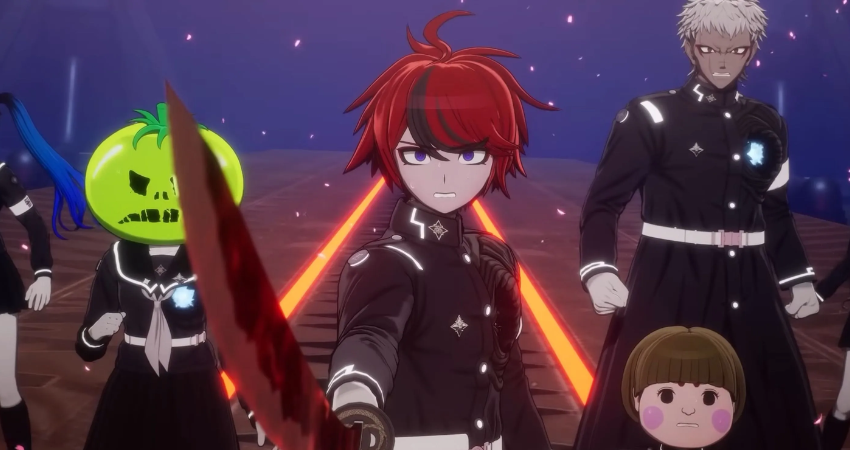Review: The Hundred Line: Last Defense Academy
The Hundred Line is a result of the collaboration between two Japanese game directors with extremely distinctive styles and huge cult followings. Kazutaka Kodaka, best known for creating the Danganronpa series (a popular visual novel series where you solve murders and dig into a deep, strange lore) and Kotaro Uchikoshi, director of the Zero Escape series (games heavy on mysteries, time travel, and huge twists) teamed up to form Too Kyo Games in 2017. The Hundred Line is the studio’s fifth game, but it’s the one that feels the most like it was made for fans of their previous work. Despite those clear influences though, The Hundred Line feels fresh and unique. It’s a strange, intense, marvellous game that’s definitely going to win over new fans as well as old.
The game casts players as Takumi Sumino, an ordinary student who lives with his mother within the confines of the Tokyo Residential Complex, a giant domed town with a synthetic sky. Early in the game, an alien invasion happens, and through a series of obtuse story mechanics Takumi is recruited into Last Defense Academy, a school in the outside world that houses a secret capable of saving the world, which has been ravaged by something called “World Death”. It’s up to Takumi – and an increasingly large cast of other young people – to protect the school from alien invaders for the next 100 days by harnessing the battle powers the academy has bestowed upon them.
Gameplay is, initially, divided into two main modes. In down time, you explore the school, talking to characters, upgrading your stats, and gathering resources to prepare for the other major mechanic – tactical turn-based combat. When the aliens invade, every member of the school activates their special power and goes to fight the aliens. It’s a grid-based combat system, not too dissimilar to something like Fire Emblem, but the key is to use each character’s unique abilities effectively to hold back the enemy and stop them from attacking the school’s shield generators.
On top of all of this, the game eventually reveals itself to be a far deeper, stranger experience than it initially seems. Once you “finish” the full game, spending 30-odd hours getting through those 100 days of school defense, battling enemies, powering up your allies, and enjoying all the twists and turns of the well-written plot – that’s when the real game begins. The Hundred Line is a game with a reported 100 different endings, a veritable feast of “what if?” scenarios that recontextualise and deepen the story. It’s somewhat reminiscent of the work Uchikoshi did on Zero Escape, but taken way further – seeing everything will take upwards of 150 hours.
Before you get to any of that, though, there’s plenty to enjoy during that initial playthrough of your 100 days. The combat system, while simple compared to what you’d find in a lot of comparable tactical RPG games, is enjoyable. Each character plays very differently, their unique abilities lending themselves to very different approaches. Using and accumulating “action points” on each turn, which dictate how you move and attack, involves a moderate degree of strategic thinking, and seeing a plan come together is hugely satisfying. It’s not the deepest style of play, but I found myself excited for battles whenever I hit a new one in the story, and the game keeps introducing new characters and mechanics to keep things fresh throughout.
The game’s script is well-written, and the excellent voice cast imbues each character with verve and personality – the more you get to know them, the more interesting they are, even the more “jokey” characters. The Hundred Line has a compelling plot even before the really weird stuff kicks in, with enough twists, surprises and reveals to hold your attention. There’s a lot of reading involved – it’s really the main thing you do in the game, in fact – but I found myself constantly compelled forward, curious to know what weird turns the game had in store. The character art, from Danganronpa alum Rui Komatsuzaki, is equal parts strange and appealing, so much so that every new character and pose reveal is a delight.

The Hundred Line perhaps isn’t for everyone. It’s slow paced, strange, and will make you wait a very long time before it answers any of the questions it raises. The combat is fun but not necessarily extremely deep, and the game’s extremely dark sense of humour can be a little much at times. But I was compelled by the sprawling, personal, ultra-ambitious storytelling. This is a game of extraordinary scale, the kind you don’t usually see in story-first design. The project’s two directors, Kodaka and Uchikoshi, have made distinct, esoteric games before, and those works are echoed here – but The Hundred Line is also something totally new and exciting. The Hundred Line: Last Defense Academy is available now on PC and Nintendo Switch. A Nintendo Switch copy was provided by the publisher.
James O’Connor has been writing about games since 2008. He is the author of Untitled Goose Game for Boss Fight Books.






